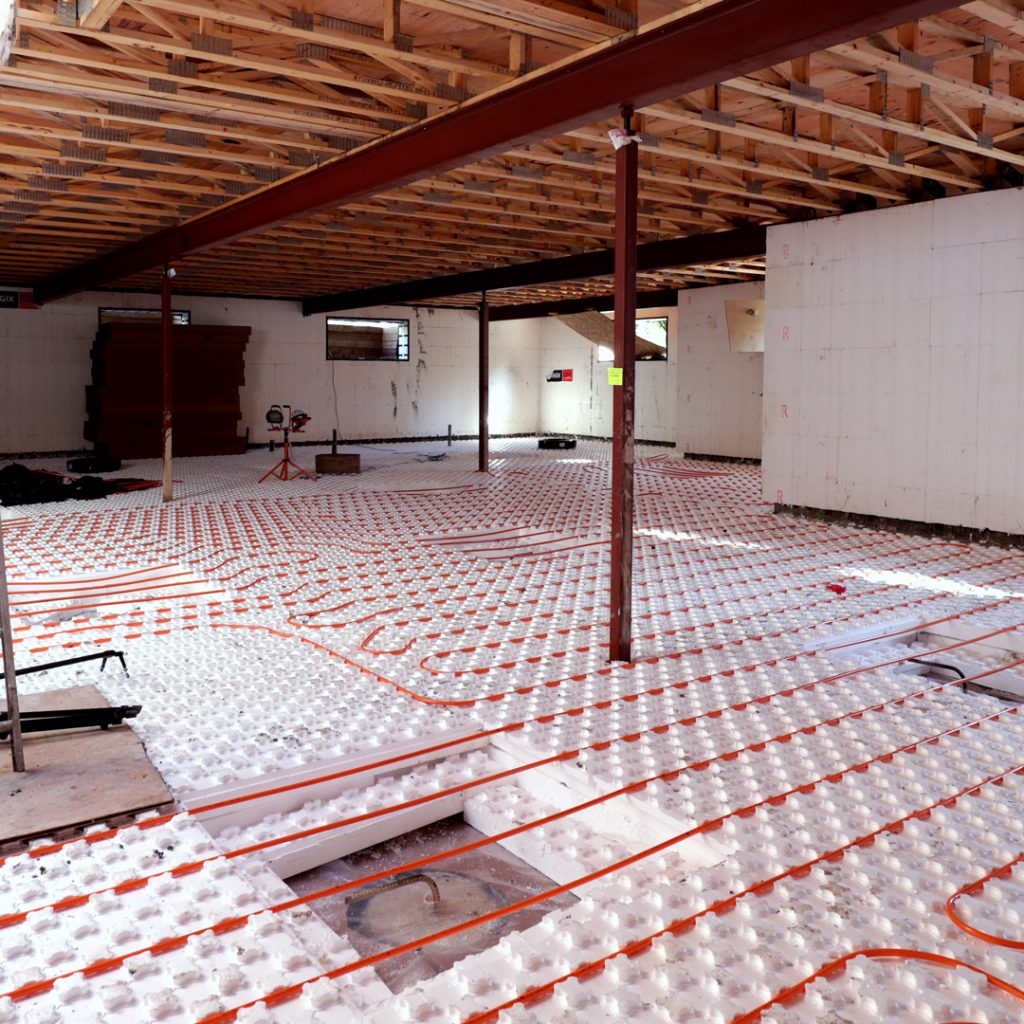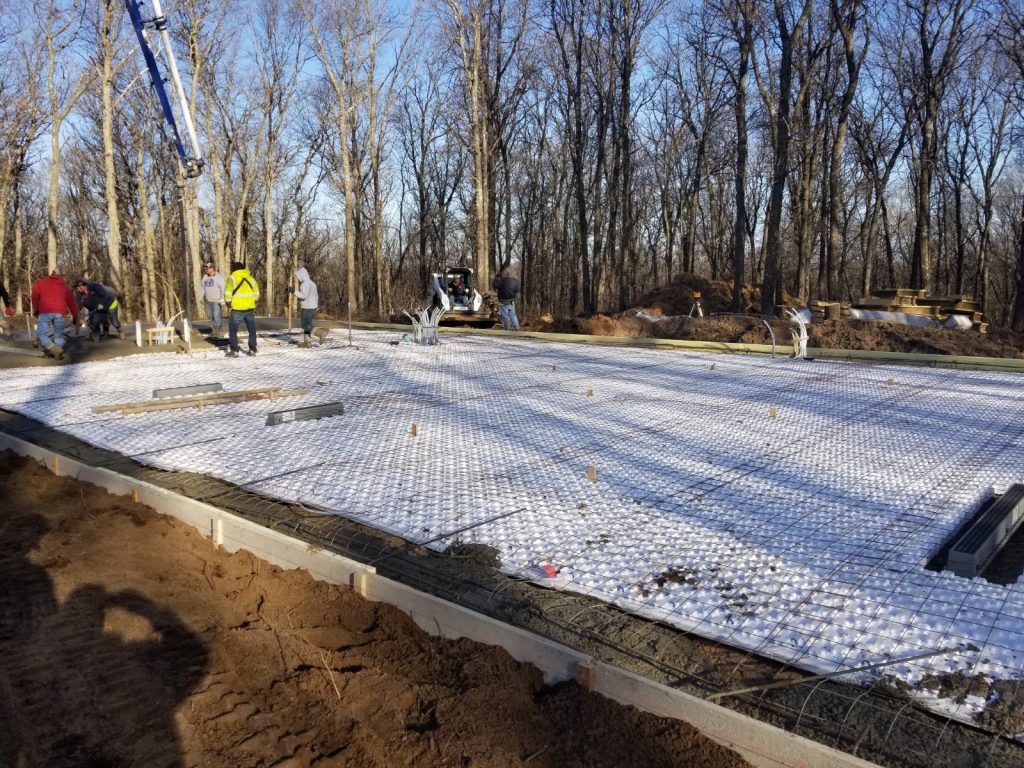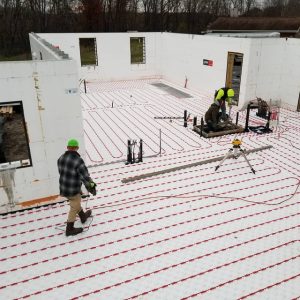They are quiet and comfortable. They do not dehydrate the indoor air. They do not spread dust and allergens around a home the way forced-air heaters do. They also consume less energy than most other heating systems.
In this post, we will compare how hydronic Radiant Floor Heating (RHF) systems, such as those supported by Heat-Sheet, measure up against other popular space heating methods.

Hydronic RHF vs. Forced-Air
Forced air systems have several flaws, most of which stem from their design. By blowing air into a space, these systems pressurize the air inside a home. In less airtight homes, as many wood-framed ones tend to be, the higher pressure drives warm air out of the house through cracks and crevices in its exterior walls.
And that’s not all. Hot air rises, and this behavior presents a challenge to both energy efficiency and comfort. When it’s pressurized and blown in through a hole in the floor or wall, the heated air has even more momentum to travel upwards. This process heats a home’s upper floors and ceilings while leaving the occupied bottom 5-6 feet of a room cooler than desired. To offset this uneven spread of heat, occupants crank up their systems and end up burning more energy to stay warm.
With Heat-Sheet’s RHF, warmth slowly radiates from a network of tubes that cover the entire floor area and disperse heat throughout the space. As the heat slowly rises, it keeps the bottom portion of a room – where the dwellers are – warm and comfy.
Thanks to these two features, Heat-Sheet’s RHF systems are felt to offer energy savings of 25% compared to forced-air heaters.

Hydronic RHF vs. Electric RHF
Electric radiant floor heating systems are often used to produce supplemental heat. Instead of circulating hot water, they rely on a network of wires to heat the floors they’re in. As a rule, electric systems reach their target heat output seven times faster than their hydronic peers. In doing so, however, they consume way more energy per hour of operation.
Though they are a worthy addition to homes with forced-air systems, electric radiant heaters lack the efficiency to be a primary source of heat.
Hydronic RHF vs. Panel Radiators
Panel radiators, the bulky contraptions are so often seen in older buildings, are a type of hydronic heater and work the same way RHF does. Hot water is sent to the wall-mounted unit, which then propagates heat into the space it serves.
The similarities end here. In stark contrast to the comfy warmth given off by RHF, panel radiators are scorching to the touch. Where a hydronic system gets to 75-84°F, the panel counterpart needs a sizzling 149-167°F to be effective.
Why the difference? RHF tubing spans the entire floor of a room, where a panel heater has less surface area and concentrates its heat close by. Even with the higher temperatures, panel radiators cannot spread the warmth as evenly as radiant flooring.
Save Even More on Energy With Heat-Sheet RHF Panels
Apart from supporting radiant floor tubing, Heat-Sheet panels are also a high performance, durable insulating product for under-slab use. Ranging from R-4 to R-20, their wide array of R-values makes Heat-Panels suited for various types of projects.
Because Heat-Sheet panels are made of Expanded Polystyrene (EPS), their R-values last much longer than Extruded Polystyrene (XPS) sheets.
As a side benefit, Heat-Sheet’s EPS panels contain almost 20 times less embodied carbon than leading XPS brands!

Don't miss a thing!
Subscribe for exclusive content, insider industry news and limited edition webcasts.

A Heat-Sheet Testimonial
Tom Gilson, owner and architect of a hybrid home in Fort Ripley, Minnesota, relies on hydronic heating, built with Heat-Sheet, for each of his home’s 3 zones. Each zone has a permanent temperature setting of 68°F, and remains comfortably warm even in the dead of those bitter Minnesota winters – all despite having 14-foot ceilings!
As Tom attests, his winter monthly heating bills do not surpass $225.
Wrapping it up
Radiant floors have kept people warm for thousands of years. They’re still popular now because they are a quiet, comfortable heat source that affords great energy savings.
Heat-Sheet’s panels make it easy to install RHF tubing and offer long-lasting R-values, top-notch job site durability and less embodied carbon.
Sources
https://logixicf.com/uploads/files/projects/ECHK43aS-Logix_ICF_Profile_Efficient_Hybrid.pdf
https://heat-sheet.com/embodied-carbon-in-eps-vs-xps/
https://heat-sheet.com/install-your-radiant-floor-tubing-4-times-faster-with-heat-sheet/
https://heat-sheet.com/what-are-radiant-floor-heating-systems/






